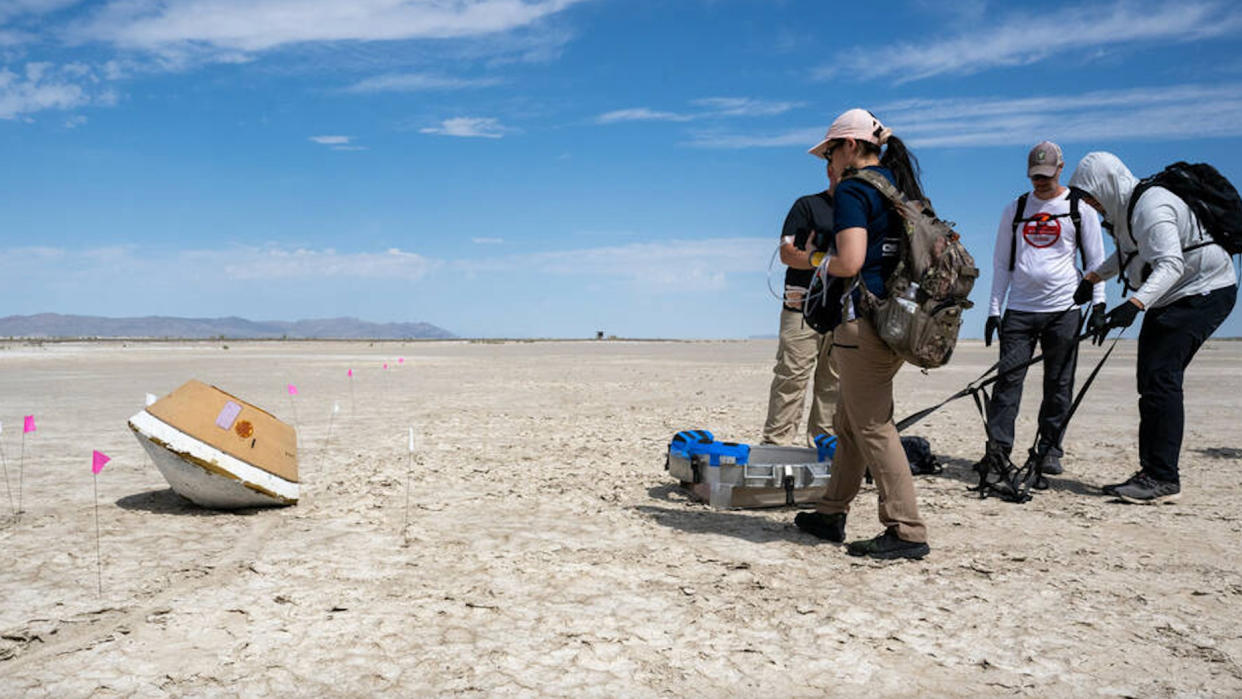NASA discussing September arrival of OSIRIS-REx asteroid sample: Watch live today

NASA will discuss the impending arrival of the asteroid sample collected by its OSIRIS-REx probe during a press conference today (Aug. 30), and you can watch it live.
That sample — about 8.8 ounces (250 grams) of dirt and gravel snagged from the near-Earth asteroid Bennu in October 2020 — is scheduled to land in the U.S. Department of Defense's Utah Test and Training Range on Sept. 24.
NASA will preview the highly anticipated event today, during a 5 p.m. EDT (2100 GMT) press conference held at the Utah site. You can watch it live here at Space.com, courtesy of NASA, or directly via the agency.
Related: Dramatic sampling shows asteroid Bennu is nothing like scientists expected

Participating in today's OSIRIS-REx press conference are:
Melissa Morris, OSIRIS-REx program executive, NASA Headquarters, Washington
Dante Lauretta, OSIRIS-REx principal investigator, University of Arizona, Tucson
Rich Burns, OSIRIS-REx project manager, NASA’s Goddard Space Flight Center, Greenbelt, Maryland
Sandra Freund, OSIRIS-REx program manager, Lockheed Martin, Littleton, Colorado
Kevin Righter, OSIRIS-REx deputy curation lead, NASA's Johnson Space Center, Houston
These folks are in Utah already for a very good reason: They're practicing for the big day.
"During the week of Aug. 30, the OSIRIS-REx mission team is testing their landing and recovery plans with the goal of reducing the time to safely retrieve the sample capsule from the desert floor and transport it to a clean room on base, protecting the rocks and dust collected from the surface of Bennu from earthly contaminants," NASA officials wrote in a blog post.
OSIRIS-REx launched in September 2016, kicking off an ambitious mission to explore Bennu, a potentially hazardous asteroid about 1,650 feet (500 meters) wide.
The mission's full name reveals the breadth of its goals and tasks: "Origins-Spectral Interpretation-Resource Identification-Security-Regolith Explorer." The "origins" part, for example, refers to Bennu's status as a primitive, carbon-rich asteroid, the type that may have seeded Earth with the building blocks of life long ago through impacts. Scientists will hunt for signs of these building blocks — carbon-containing organic molecules — in OSIRIS-REx's sample, once it's down on the ground.
And "security" is a nod to Bennu's potentially hazardous nature: Learning more about this space rock could inform our efforts to deflect a dangerous asteroid away from Earth, which, experts stress, we'll need to do at some point in the future.
RELATED STORIES:
— OSIRIS-REx: NASA's asteroid study and sample return mission
— The greatest asteroid missions of all time!
— NASA's OSIRIS-REx probe could make a 2nd stop at infamous asteroid Apophis
OSIRIS-REx arrived at Bennu in early December 2018, then slipped into orbit around the space rock four weeks later.
Bennu is the smallest object ever orbited by a spacecraft. And OSIRIS-REx set another record during its visit as well: It performed the closest-ever orbit of a small body, skimming just 1 mile (1.6 kilometers) above the asteroid's rubbly surface.
OSIRIS-REx took the space rock's measure from orbit for nearly two years. Then, in October 2020, it dove down for an epic sample grab — and nearly got swallowed up by the surprisingly spongy Bennu in the process.
But OSIRIS-REx survived its encounter. The probe departed Bennu in May 2021 and began the long journey back toward Earth. While its sample capsule will touch down here next month, the probe itself will keep on flying; it will head toward a second potentially dangerous asteroid, the notorious Apophis, arriving at the space rock in 2029.
OSIRIS-REx will study Apophis up close, gathering yet more data that could teach us about the solar system's formation and evolution — and, potentially, help us defend our planet down the road.

